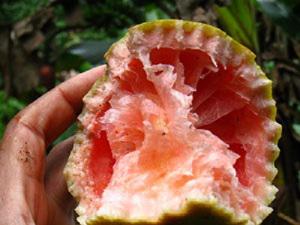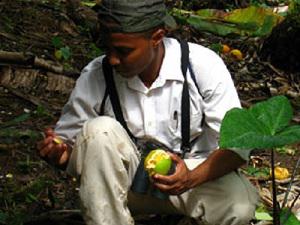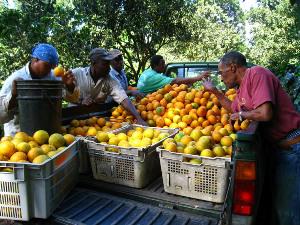Leo Douglas
This project will develop the tools to study this threat and quantify the importance of threatened endemic parrots as a source of citrus crop loss relative to other causes of losses in the citrus agriculture landscape. The methods developed and lessons learned will be incorporated into Dominica's national plan for protected areas and institutionalized in the responsible government agencies.

Pink grapefruit damaged by an Amazona arausiaca parrot on Dominica.
Conflict between psittacines and agriculture is a growing, unstudied threat to conservation throughout the Caribbean. The re-emergence and intensification of conflict as an apparent outcome of successful conservation interventions is of particular concern on the island of Dominica. Here, conflict between the island's two globally threatened parrots and citrus farmers is a potential roadblock to advancing the gains of threatened species recovery programs. While the state of conflict is considered serious, the current situation on Dominica is one of complete absence of empirical data on either the extent or severity of the (real or perceived) economic losses experienced by farmers due to parrots, or the degree to which the resulting conflict has provoked a parrot conservation backlash.

Crop damage assessment.
What are the causes of citrus fruit loss and what is role of parrots in these losses? What is the geographic distribution of the conflict, and are there are environmental variables that can predict where parrot frugivory occurs? This project aims to fill these information gaps through systematic data collection. Therefore over a citrus fruit harvesting season of six months, using a representative subset of the citrus-agriculture landscape in Dominica,

Citrus harvest market.
I will:
(1) Systematically determine the relative economic importance of parrot frugivory. I will monitor geographically dispersed farms across Dominica. On each farm, I will determine the yield/damage ratio by performing weekly fruit counts, and quantify the animal sources of crop loss using fruit-bite characteristics (whether by parrot, passerine birds, or mammals) on randomly selected trees.
(2) Assess the importance of environmental variables that may explain parrot frugivory. I will record the landscape and farm-level environmental characteristics of all study sites using both onsite and remote-sensed data and subsequently test the relationship between the yield/damage ratio and these variables.
(3) Undertake targeted capacity building. I will train one student of the Dominica State College and a government officer in the research techniques used, and lead workshops on parrot conservation and parrot-agriculture conflict for the Forestry, Wildlife, and National Parks Division, faculty of the Dominica State College, and the Crop Depredation Task Force of the Ministry of Agriculture.